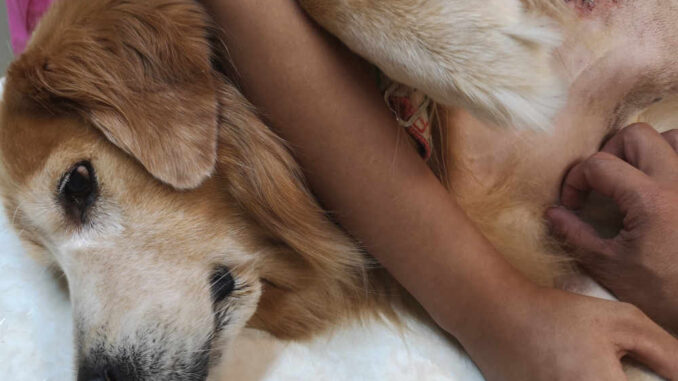
This article was updated on June 23rd, 2024
When you find a new lump on your dog, it’s easy to dismiss it as something harmless. In fact, I often see pet owners take a pass when the veterinarian recommends a biopsy on a lump. Owners don’t usually think it’s necessary to biopsy a lump that has been there for years, especially if they don’t think it’s causing problems for their dog. However, lumps can suddenly grow, causing a host of problems for your dog.
This is the case with mast cell tumors, commonly called “the great pretenders” in veterinary medicine. Mast cell tumors have a reputation for mimicking many (non-cancerous) skin lumps. And because of their inconsistent appearance, they can go unchecked for months or even years, causing a wide range of symptoms for dogs affected by them.
Grading mast cell tumors aids in diagnosis, life expectancy estimates, and determining treatment plans.
Mast cell tumors are graded in three categories. The grade of a tumor is determined by a pathologist. In order to grade a tumor, it must be biopsied or removed by your veterinarian. The tissue will then be examined by the pathologist under a microscope. The pathologist will count the number of mast cells compared with healthy cells to determine the grade of the tumor.
Grade 1 tumors and life expectancy
Grade 1 tumors are “well-differentiated”, meaning they have a good number of healthy cells compared with cancer cells. At this grade, your dog may have a small or large lump. It could be hard or soft, and a range of colors. The lump could appear out of nowhere, or it could even shrink and grow from day to day.
Grade 1 tumors are the easiest to treat. Most dogs with these tumors will fully recover with no tumor regrowth after surgery. If all the cancer cells are removed during the surgery, “the prognosis for even incompletely removed grade 1 or 2 tumors treated with radiation after surgery is excellent, with 90-95% of dogs having no reoccurrence of tumor within 3 years of receiving radiation therapy.”1
Dogs with low-grade, stage 1-2 tumors can usually be treated with:
- Surgery
- Antihistamines
- Steroids
- Antacids
The veterinary surgeon will remove large margins (around 2-3 cm) of healthy skin around the tumor. This will ensure most of the cancer cells are removed. The tissue removed during the surgery will be sent to a pathologist and microscopically examined.
Grade 2 tumors:
Grade 2 tumors are moderately differentiated, meaning they have a moderate amount of mast cells compared with healthy cells. At this grade, your dog may have one or more tumors and they may grow quickly or appear very irritated. These tumors are more likely to have grown into the deeper layers of the skin.
Dogs with high-grade, stage 2-3 tumors will often require a combination of:
- Surgery
- Chemotherapy
- Radiation
- Antihistamines
- Steroids
- Antacids
Similar to a grade 1 tumor, grade 2 tumors are treated with surgical removal. At this grade, chemotherapy is usually recommended, along with surgery. Because of the high amount of cancer cells present in Grade 2 tumors, there is a higher chance that some cells could be left behind after surgery. Chemotherapy and radiation treatments are used to kill off any of the cancer cells left behind, further decreasing the chances of the tumor growing back.
Grade 3 tumors and life expectancy:
Grade 3 tumors are poorly differentiated, meaning that when the pathologist looks at the cells under the microscope, they will see mostly mast cells and very few healthy cells. Your dog may be very ill at this stage, with one or more tumors covering the skin. The tumor will probably be ulcerated and irritated.
Your dog may also exhibit other symptoms caused by the spread of the cancer. Some symptoms your dog may show are:
- Itchy skin
- Welts
- Vomiting
- Weight loss
- Loss of appetite
- Abdominal pain
- Diarrhea
Grade 3 mast cell tumors are so aggressive that your veterinarian will likely recommend surgery, medications, chemotherapy, and radiation. At this grade, surgery may not be an option. If surgery is not an option, your veterinarian will focus on keeping your dog comfortable rather than eliminating the cancer.
Grade 3 tumors have mostly abnormal mast cells and are the most dangerous type with a high metastatic rate (94% mortality rate from tumor-related disease).
With surgical removal and chemotherapy, the average life expectancy of a dog with a grade 3 mast cell tumor is 12 months. With surgery alone, about “50% of patients will live to 6 months after tumor removal.”
The Kiupel 2-tier grading system (low grade & high grade)
There is another grading system for mast cell tumors that is similar to the Patanaik system, but it breaks the tumor types into two categories:
- High grade- highest chance of spreading; life expectancy is four months after surgery.
- Low grade- lowest chance of spreading; dogs often live a normal life after surgery.
Both grades can be reported
The Oncology-Pathology Working Group (OPWG) at the Veterinary Cancer Society recommended combining the two grading systems to better predict the behavior of certain mast cell tumors and study survival rates. Mast cell tumors are thus categorized in one of the following:
– Grade I/low-grade
– Grade II/low-grade
– Grade II/high-grade
– Grade III/high-grade
How long will my dog live with a mast cell tumor?
Because every dog with a mast cell tumor is different, it is hard to say how long a specific dog will live. There haven’t been enough studies done yet, but according to current information, your dog’s length of life will depend on:
- The stage of the tumor
- The grade of the tumor
- The location of the tumor
- The number of tumors
- Your dog’s overall health
In a 10-year-long study, results found that out of 149 dogs, 65.1% had no new tumors, no spread of cancer, and no deaths after diagnosis. The same study showed that 30.8% of the 149 dogs passed away within 1020 days of diagnosis.
Grading and diagnosis with a procedure called FNA (“fine needle aspirate”)
Tumors can easily be checked by your veterinarian with a procedure called a FNA, or a fine needle aspirate. During this procedure, your veterinarian will insert a small needle into the lump to collect some cells. After collecting the sample, your veterinarian will send it off to a laboratory. At the laboratory, a pathologist will examine the sample for cancerous cells. It usually takes about a week for the results to come back for this type of test.
Quality of life by grade
Your dog’s quality of life will depend on the stage of the cancer and his general health. Many dogs can live life with few complications, especially when the tumor is caught and treated early on.
Quality of life with low-grade tumors:
Luckily, low-grade tumors that are caught early have a good chance of being removed successfully. According to one study, roughly “80% of mast cells are low-to-intermediate grade and unlikely to reoccur after surgery.”
Quality of life with high-grade tumors:
Because high-grade mast cell tumors are the most aggressive, it is very important that these tumors are caught early. These tumors have a higher chance of spreading to the lymph nodes and metastasizing (spreading to other organs in the body.) Once a tumor spreads to the organs, the chance that your dog will live a normal life is very low. Tumors that metastasize will cause a lot of symptoms, so at this grade, the focus of treatment will be on keeping your dog as comfortable as possible.
There are many medications that can keep your dog more comfortable throughout the treatment process.
For instance, antihistamines like Benadryl are used to calm down the allergic response in your dog’s blood, making them less itchy. Prednisone is a steroid that can also help decrease inflammation and itching. Antacids are used to soothe the stomach and decrease the nausea caused by irritation in the stomach.
Sometimes a tumor can be too big to remove, or it can be in an area that makes it impossible to perform surgery.
In these cases, veterinarians can offer palliative care (comfort care). Palliative care usually includes “4 weekly doses of radiation, followed by a 15-week course of chemotherapy”. A combination of radiation and chemotherapy can decrease tumor size. Additionally, your veterinarian will likely include medications to control symptoms of stomach upset, pain, and itching. Palliative care is for patients that cannot be cured of the cancer. However, it offers improvement in symptoms. The average survival time for patients that receive palliative care is 3 months.
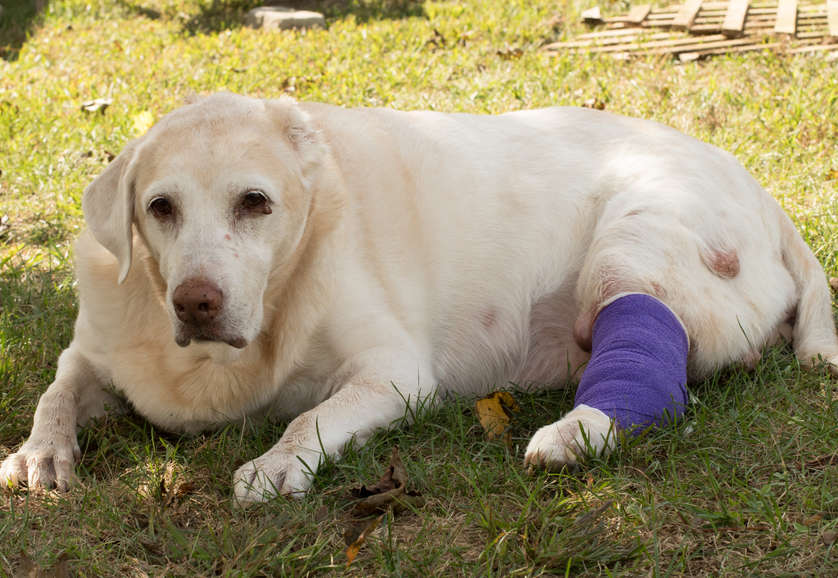
Both chemotherapy and radiation are tolerated pretty well by most healthy dogs (with a risk of side effects)
However, it is important to remember that chemotherapy wouldn’t be used if the benefits didn’t outweigh the risks. Dogs receiving chemotherapy will need to have a full health evaluation before treatment. This will include bloodwork to check for any abnormalities in cell or organ function. Bloodwork is a great way for your veterinarian to determine if your dog is a good candidate for chemotherapy.
However, with chemotherapy, there is always a risk of side effects. Some of the side effects seen in dogs undergoing chemotherapy are.
- Vomiting
- Diarrhea
- Dehydration
- Low white blood cell count
- Bladder irritation
Tumor removal surgeries can cost anywhere from $700-$1,800 dollars or more
The cost of treatment for mast cell tumors is variable and depends on several factors. Things like the number of tumors, the size, and location of the tumors, and your geographical location will all affect the cost of surgery.
- Chemotherapy can cost anywhere from $3000-4,000 dollars.
- Radiation can also be quite pricey at about $2500-7,000 for 3-6 months of treatment.
- Prescriptions like antihistamines, steroids and antacids are typically the most affordable part of mast cell tumor treatment, costing typically around $20-50 a month.
Takeaway
Overall, there is hope if your dog has a mast cell tumor. The most important thing you can do as a pet owner is have your dog’s new lumps checked by your veterinarian as soon as you notice them. The good news is that tumors caught early are treatable and unlikely to return.
Related Articles About Mast Cell Tumors:

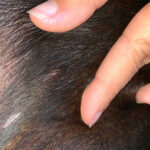
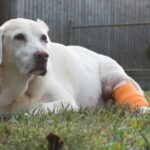


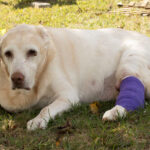
Disclaimer: This website's content is not a substitute for veterinary care. Always consult with your veterinarian for healthcare decisions. Read More.


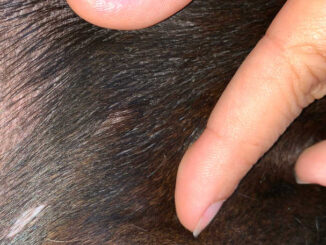
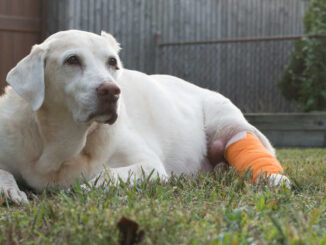
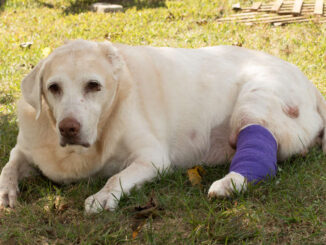
Be the first to comment